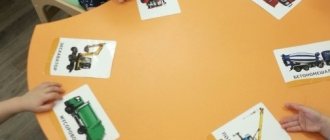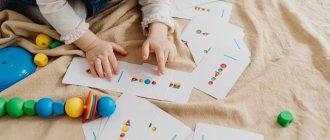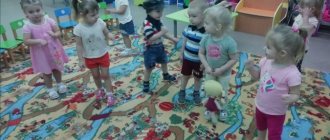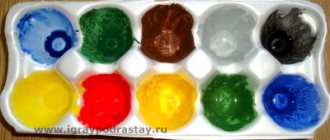Early childhood. Cognitive development. 1-3 years. Toolkit
Getting to know your surroundings
The cognitive activity of children, especially infants, is qualitatively different from the cognitive activity of an adult.
Firstly, it is not singled out as a special, specific activity, but is manifested in all the diversity of effective development of the environment, intertwining with other leading lines of child development. This is determined by the development of perception, the formation of basic movements, improvement of hand actions, mastery of speech, acquisition of the first social skills, etc. That is why the task of developing a child’s cognitive activity is no less significant than strengthening his health and creating the necessary conditions for full physical and emotional health. mental development.
Secondly, an adult is able to determine the range of his own interests and, striving to understand the essence of a phenomenon, highlight the main and secondary things in it, reveal the causes, consequences, and patterns. A child of the first year of life is not capable of such complex activities, but a start has already been made: he shows interest in everything around him.
The baby's attention is usually attracted to everything moving, bright, and making sounds. He tries to understand the world that appears before his eyes. But the child shows the greatest interest not in objects, but in an adult who picks him up, carries him from place to place, talks to him, smiles at him, shows him toys, and performs various actions with different objects. It has been established that a person’s face and his speech are the most significant for a child in comparison with all other “signals” from the surrounding world, i.e. already in the first month of life, a child distinguishes a person from all the diverse reality, reacting in a special way to his emotional manifestations, verbal communication, actions.
The first manifestations of a child’s cognitive activity are associated with indicative reactions,
on the basis of which first a response to external influence arises, and somewhat later a kind of manipulative activity with objects. At the same time, the child’s activity is supported by such a property of indicative reactions as the ability to arise with the appearance of each new object. It is no coincidence that orientation reactions are otherwise called “reactions to novelty.” It is this function of the brain that explains the child’s inexhaustible interest in the world around him, which is so large and diverse for him that in the first months the child’s life is a chain of countless, successive orienting reactions.
Children's first knowledge about the world around them develops in the process of mastering the nearby space (crib, playpen, room, playground, etc.), which is why the organization of the subject environment is so important. Indicative reactions occur in a child already in the first month of life and are an objective condition for his full development. Adults notice how the expression of the baby’s eyes changes day after day, with what tenacity and persistence he reaches out to everything that attracts his attention, although he cannot express his desire. And not only because he does not know how to speak, but also because he does not yet realize it (desire).
Let us trace the features of a child’s indicative behavior during the first year of life.
.
The nervous system and sensory organs of a newborn child provide not only the perception of visual, auditory, tactile, and temperature stimuli, but also an elementary analysis of their quality and strength. This helps the baby to identify everything new and new in the environment, and over time, analyze it more differentiated.
We can say that the first “knowledge” appears in the baby on his ninth birthday, when, as scientists testify, the first conditioned reflex is formed. Based on food and orientation reactions, a relatively complex orientation behavior is formed: as soon as the baby is placed in a position characteristic of feeding (“position under the breast”), he opens his mouth. This is how he behaves when he sees a bottle of food for him. And during the first month of life, the child begins to distinguish, for example, a bottle of water from a bottle of formula, that is, to respond to color.
By the end of the first month, the baby begins to recognize his mother, tries to respond to her smile, and at the end of the third month he reacts to the appearance of his mother with his whole being ( revitalization complex
), expressing her love and desire to communicate. (By the way, such an attitude can be formed in a baby towards any person who cares for him and loves him.)
The emotional reaction of an adult to a child’s need to explore the world around him is very important. If he has lost sight of the rattle he was looking at, do not ignore it: shake or roll the colored balls, and the child will turn his attention to the toy again. (This is how the child reacts not only to toys, but also to household items, pictures, etc.)
A baby who does not yet know how to roll over onto his stomach is already able to occupy himself during waking hours: he examines his hands, “listens” to himself, reacts to changes in the position of his body in space (he is swaddled, laid down, turned over on his side or stomach), to touch your palms to the body, movements of your fingers.
In a child of 2.5–3 months, elementary cognitive activity can already be observed. Show him a bright object without drawing attention to it. The baby will smile, reach out to him, and try to grab him. Unsuccessful at first, but he will do it again and again.
In the development of nearby space, skin sensitivity is of particular importance. The child does not yet know how to hold objects in his hand, but when touching them, he feels the originality of their surface. In the first months of life, the child is not capable of consciously examining an object: he comes into contact with the object, accidentally touching it with his hand, but by 3–4 months he can grasp it with his hands.
Grabbing
- the first action of a cognitive nature available to an infant, associated with the development of the objective world and space. During the first year of life, the actions of the hand constantly become more complex, playing a primary role in cognition of the properties of objects.
When a child begins to sit up independently, the visible world of objects appears before him in a new way. Now it’s more convenient for him to look at everything that surrounds him. The child peers at the actions and movements of adults, at the movement of objects in space. Increasing the sphere of vision helps to intensify cognitive activity, encouraging effective exploration of the world.
Lying on your side, back, stomach; sitting and standing, the child sees the world around him differently. He reveals the diversity of objects: a pyramid, a matryoshka doll look different if you look at them from above, and not from the side.
Many new objects appear before the baby when he begins to walk. Although he is still unsteady on his feet, it is difficult to keep him in place - the desire to get to know the world around him is so strong. Therefore, by changing and arranging objects in new ways, adults encourage the child to take his first independent steps. Every day the world opens its horizons wider and wider to him. Gradually, the baby masters various actions with objects: puts one object on top of another, removes the rings from the rod of the pyramid and puts them on again, etc.
In a child of the first year of life, interest in an object is determined primarily by the possibilities of practical actions with it: he receives pleasure both from the action itself (opening, closing, removing, etc.), and from various changes in the object that arise due to his actions, which and supports the child’s activity and contributes to the emergence of a more sustainable interest in the subject and its properties.
The child’s actions reveal the first cognitive reactions to an object and its properties. It is difficult to understand whether a child is playing or exploring an object when he examines it, turns it over, hits it, puts it in his mouth, etc. He does the same with any toy, so his activity can be called an introductory game, and his actions are exploratory in content. A child can be occupied with an object for quite a long time if more and more new properties are discovered in it. Then a chain of indicative and cognitive reactions follows one after another, which prolongs interest in the subject. This is the uniqueness of early cognitive activity.
Compare the behavior of a 6- and 12-month-old child, and you will see that a one-year-old child is able to play for a longer time and react more selectively to the environment than a six-month-old child: he plays with one toy for 5–10 minutes; he has a favorite toy that he prefers.
While exploring an object, the child often throws it on the floor, knocks it, licks it, and bites it. The desire to “get to know” an object with his mouth arises very often in him, therefore, in the “toy farm” there should be no dangerous objects: prickly, small, painted with harmful dyes, etc. In addition, the set of toys must be age-appropriate, and cognitive activity during examination their properties must be organized, directed and controlled by adults. This is also necessary because the baby has no sense of fear of the unknown.
Communication with adults is a necessary condition for the cognitive development of a child and his mental education.
To help a child grow up inquisitive, an adult must first of all take care of organizing his wakefulness and independent activities. Waking time must be used rationally: talk with the baby, show toys and techniques for using them.
Games-activities,
conducted by an adult, should contribute to the timely and harmonious development of the child (physical, mental, moral, aesthetic, etc.). They form in children skills that cannot be developed in the process of independent activity, i.e. in classes they teach what the child cannot master on his own.
Adults need to take care of instilling sustainability in their actions.
child during object-play situations. The baby has not yet developed voluntary attention, and he is quickly distracted from one object to another. (However, you should know that a one-year-old child is able to concentrate on an object for 8–10 minutes, and this is an indicator of normal neuropsychic development.)
What pedagogical conditions contribute to the development of sustainability of actions with objects?
First of all, this is the absence of any distractions at a time when the baby is busy with his “research”, and such factors can be new objects, sharp sounds (loud conversation, noise).
Sometimes an adult considers it possible to interrupt a child’s activities at any moment, not realizing that this is one of the sources of knowledge of the world: it is more important for him to feed him, put him to bed, walk with him, etc. Undoubtedly, providing for the child’s vital needs is necessary, but no less important and his state of mind for his psychophysical well-being. That is why you should be careful about your child’s activities.
If he is able to occupy himself by looking at objects, manipulating them, trying to understand their properties, and can do without the help of adults, he should not interfere in his “affairs.” With such “non-interference,” the adult will contribute to the development of activity and independence of the child.
It's another matter if the child does not know how to act with a new toy. Then you need to get involved and show how to handle the object. But even in this case, you should try to intensify the search actions of the baby himself. There is no need to reveal all the “secrets” at once.
It is advisable to present the toy in such a way that the child has the opportunity to make “discoveries” on his own: let him discover the hidden properties of the toy and options for playing with it. The problematic nature of situations shapes character traits such as determination and perseverance in achieving goals.
An adult must be attentive to all problems that arise in the baby when operating with objects. And if he fails to get a positive result for a long time, if he gets nervous and eventually throws the toy away, then the adult is obliged to “defuse” the situation, that is, to engage in active play actions and help him reach the finale with victory. In this case, it is necessary to praise the baby, and then offer to independently repeat what he did not succeed at first.
Adults should know: the visible result of an activity increases the child’s interest in the subject and the desire to master ways of working with it. Consequently, problem situations are very useful: they contribute to the formation of focus and activity in cognitive activity.
But the child enjoys not only the result, but also the process itself, i.e., the path to achieving it. “Searching” situations attract the baby. It is important that they end successfully and are accompanied by joyful emotions: this will support the desire to continue to examine the object or toy.
You should know: before starting to play with any new toy, the child “examines” it - this is an indicative research activity that precedes play. In other words, before starting to play, the child finds out what can be done with this new toy, based on the properties that he manages to discover in it. Approximate research stage of activity
consists in discovering, researching, ascertaining the game properties of an object.
These actions then move into the second stage - play actions with the toy.
In the conditions of family education, the child has much more opportunities to get acquainted with the environment than in the conditions of public education. Being in the arms of one of the adults, he watches everything that happens around him. As a rule, a child is attracted to bright, shiny, colored objects that contrast with the general background of the room (for example, an iron or a kettle, a colander or can, a table lamp or sconce, etc.). Moreover, these and other objects in the hands of adults change their position in space and appear before the child in different ways. This supports his orienting and cognitive activity, causing interest in the most ordinary things. For example, my grandmother took the iron, and it “moved” across the fabric forward and backward, right and left. Or: a crystal “fountain” (sconce) hanging on the wall lit up with all the colors of the rainbow. A 3-4 month old child looks at the wallpaper design with interest (isn’t this what makes him later enjoy drawing on the wallpaper, despite the prohibitions?!). In the bathroom he looks at bottles, jars, tubes, brushes. He is attracted to the mirror and gazes with interest at its surface and at his own reflection, not realizing that he is seeing himself. In this situation, it is useful to change the child’s position in front of the mirror. For example, if he is sitting on his dad’s shoulder, move him to the other shoulder, raise his hand, wave it, saying: “Where is grandfather? Here's grandfather! Where is Vasya? Here is Vasya,” and point his hand at his grandfather, and then at himself.
The sooner they begin to familiarize the baby with the objects of his immediate environment, the richer his sensory experience will be. However, it is necessary to highlight a number of items that should not be given to a child: these are expensive vases, figurines, gold jewelry and jewelry, indoor plants, tea and table sets, crystal glasses, etc. The child can only look at them from a distance. And this should become the rule for all family members.
When the child begins to sit up independently, he takes a more comfortable position in the arms of an adult - “facing him.” From this moment on, they become partners in getting to know their surroundings. The baby not only looks at what the adult is showing, but also listens to the name, becomes emotionally enriched, feeling the adult’s attitude towards what their attention is drawn to. For example, looking at a figurine, an adult explains: “This is a girl. She is wearing a dress and a scarf. What is the girl doing? She feeds the hen and chicks. Chick-chick-chick! Here are the chickens... Where is the girl? Where are the chickens? Girl...Chicks..." The examination lasts 1–1.5 minutes. The adult speaks concisely, clearly naming objects. His speech is somewhat slow, with pauses.
At 7–8 months, the child is attracted to paintings and books with bright, large illustrations. He examines them with interest, sometimes trying to “study” the material from which they are made, that is, to crumple or tear the picture. An adult must anticipate this and prevent it by strictly saying: “You can’t!” - and taking the book or picture away from the child for a while. Then, together with your child, look at them again, commenting on what they see.
Of particular interest to children are objects of decorative and applied art: wood products (spoons, nesting dolls, various toys - “pecking chickens”, “lumberjack bear”, etc.), fabrics (towels, aprons, embroidered scarves) . Painted scarves (including Pavloposad shawls) can be used for playing hide and seek and for dressing up. First, you should draw attention to the drawing (“Flowers! Where are the flowers?”), stroke it with the child’s hand, throw a scarf over yourself, and ask: “Where is mommy?” Taking off the scarf, exclaim: “Here is mom!” “Where is Vasya?” “Hide and seek” helps the child find out his name (he will remember it a little later - by about one year). Dressing up also helps with this: having dressed the child in a scarf, bring him to the mirror and ask: “Where is mommy?” Where is Olya in the headscarf?”
You can look at the Zhostovo tray with your child, naming what is depicted on it and noting the color. The main thing is to impress the child and enrich his emotional world.
Both Dymkovo and Gzhel toys are useful for this. They are carefully brought to the child and examined with him with the explanation: “This is a horse! And this is a cockerel! Ku-ka-re-ku!
As a rule, children are attracted to television, but it is not recommended for them to be in front of the TV screen. From a distance of 4–5 m, you can watch a cartoon lasting no more than 5–8 minutes, discreetly commenting on what is happening (“The girl is singing,” “The bunny is jumping,” etc.).
On New Year's Day, a 6-7 month old child will definitely be interested in a Christmas tree decorated with toys and colored with lights. Taking him in his arms, the adult brings the child to the Christmas tree and gives him the opportunity to examine it: “This is a Christmas tree, a Christmas tree!” Then he sets some toy in motion: “This is a ball. Red ball. This is a bump. This is a top,” etc. Then you can ask questions: “Where is the ball? Where's the bump? The child responds to the question “where” by looking for the named object with his eyes and showing it with his hand.
At 11–12 months, the child takes his first independent steps. Remember: it should not be left unattended. Interest in the environment can lead a child to injuries: after all, he does not yet know his capabilities, does not suspect some of the insidious properties of things. He may reach for a hot kettle, sharp or breakable objects. This is why in preschool institutions children aged 8–12 months are placed in spaces specially equipped for them (separated parts of the room).
1. WHERE IS THE DOG? Goal: to teach to perceive and distinguish living things from the environment - a dog. Progress of the game An adult organizes the child’s observation of the dog, draws attention to the fact that it runs, barks, eats, wags its tail, it has a head, a torso (body), a tail and paws. The dog can be found on the street with its owner. Then he shows a toy dog, gives him the opportunity to play with it, reads a poem about it, and then with the child looks for an image of a dog in the picture, highlighting it among others: “Here she is, a dog, she can bark - “woof-woof.” 2. “GET TO KNOW THE BIRD” Goal: to teach to perceive and identify living things from the environment - a bird. Progress of the game An adult organizes the child's observation of a bird in a living corner or on the street, drawing his attention to the fact that the bird has a head, a torso (body), wings, legs, it can walk, fly, sing, and peck grains. Then he shows the toy, gives the opportunity to play with it, reads a poem about a bird, performing the actions: Bird, bird, here's some water for you. Here are the crumbs on my palm. Then he and the child search for the image of a bird in the picture, highlighting it among others: “Here she is, a bird, she can fly and sing.” 3. “BEAUTIFUL FLOWER” Purpose : to teach to perceive and distinguish a plant - a flower - from the environment. Progress of the game An adult organizes a child’s observation of a flower during a walk, draws attention to the fact that it grows on the ground, blooms, smells, and decorates nature. He offers to bring it to the group and put it in a vase. After observations during a walk, the teacher shows a flower of a houseplant, invites the child to water it and smell it. Then together they look for the image of a flower in the picture. 4. “SAIL, SHIP!” Goal: to introduce water, highlighting it as an object of inanimate nature. Equipment and material: water pool, floating toys. Progress of the game An adult invites the child to see that there is water in the pool, to touch it with his hands, pays attention to his hands - they have become wet. Then they lower the toys into the water, watching them float, blowing on them, causing movement: “Swim, boat” 5. RAIN Purpose : to teach to pay attention to the phenomenon of nature - rain. Progress of work In rainy weather, an adult organizes observation of this natural phenomenon during a walk. Places a bucket (basin) to collect rainwater. Draws the child's attention to puddles that form after rain, drops of water, clouds from which it rains. He notices that people are walking in raincoats, under umbrellas, and in boots. After observation, the teacher draws clouds and invites the child to draw rain (drip-drip). Then he finishes drawing the puddles and recites poems about the rain: Rain, rain, drip-drip-drip. wet paths. Anyway, let's go for a walk, put on boots 6. “LET'S MAKE A PATH” Purpose : to teach to identify an object of inanimate nature - sand, to develop interest in playing with sand. Material : scoop, bucket, machine. Progress of the game In sunny weather, the adult organizes games with the child in the sandbox. Shows that you can dig sand, put it in a bucket, and build towers from it. Then he gives the child a scoop and offers to pour sand into a bucket. Then together they pour it out of the bucket and build a path for the car. 7. “ZOO” Goal: to continue to teach how to identify objects of living nature, to develop interest in observing their actions and movements. Progress of the game An adult organizes a trip (no more than 30 minutes) to the zoo, where he draws the child’s attention to animals, birds, their habits and movements. After visiting the zoo, he shows pictures of familiar animals and asks to find them by name.
Junior group. Early childhood, nursery. Children 1-4 years old
OD summary on familiarization with the outside world and speech development in the second group of early age “Putting the doll to sleep”
Municipal budgetary preschool educational institution "Kindergarten N10"
Summary
of a lesson on familiarization with the outside world and speech development in the second group of early age “Putting the Katya doll to sleep” Goal: to teach children to understand words and pronounce them. Type of lesson :...
Lesson on the world around us “Visiting grandma. Pets" for children from 2 to 3 years old Goal: development of cognitive interest in the world around us . Progress of the lesson : Educator: Guys, guests have come to us. Let's say hello to them. Children: Hello! Educator: Doll Masha baked pies and asked to take them to grandma. Educator: Do you want to go visit...






